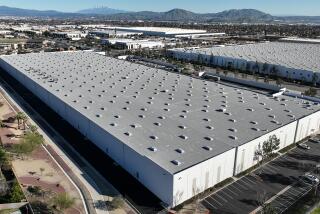LANDMARKS / COUNTY HISTORICAL SITES : Saticoy Walnut Warehouse Rode a Boom
- Share via
HISTORY: In 1919, the Saticoy Walnut Growers Assn. responded to expansion of walnut production in Ventura County by building a warehouse from which locally grown nuts could be sent to market. The warehouse was expanded in 1921 and continued to be used until 1962, when walnut growing declined in the area. The building was sold and now serves
other purposes.
* LOCATION: The warehouse is located at 1235-1255 Wells Road in Saticoy. To the southeast is the Southern Pacific railroad main track, to the northwest is Telephone Road.
* VIEWING: Contact the county Cultural Heritage Board at 654-3967 to arrange a visit.
Late in the 19th Century, Ventura County began to emerge as a walnut production center. In 1896, the Saticoy Walnut Growers Assn. was formed by five landowners and farmers from Saticoy and Santa Paula.
In 1919, the association built a warehouse in Saticoy, where walnuts could be processed and shipped to market on the Southern Pacific railroad.
The nuts were washed and bleached to remove dirt and stains and then laid out to dry in the sun. In the 1920s, local resident Eugene Kimball designed and built a dehydrator to dry the walnuts with greatly reduced losses.
Workers were hired seasonally--women to look for imperfections in the nuts and determine quality, men to load the sacks onto railroad cars and later onto trucks. The nuts were shipped to Los Angeles where they were shelled.
The warehouse has an irregular shape. The main part of the building stands 1 1/2 stories high, is 80 feet wide and 200 feet long with a gable roof supported by heavy triangular wood trusses.
In 1921, the southerly part of the building was added. Also gable-roofed, it is three stories high and sits at a 90-degree angle to the main section. A one-story annex extends west from the taller section. Horizontal wood siding covers the entire building.
Charles C. Teague of Santa Paula, a past president of the Walnut Growers Assn. and active in citrus growing as well, was appointed in the early 1930s by President Herbert Hoover to the Federal Farm Board.
Jim Sharp, grandson of a founder of the association and son of a past president, redesigned and rebuilt the old processing equipment in the 1950s. An electrical engineer, Sharp added a vacuum for empty shells and infrared heat lamps for faster drying.
At the peak of the industry, around 1956-57, 6,000 tons of nuts passed through the warehouse each year. At that time, it was the largest walnut facility in the world.
By 1962, production had fallen to 880 tons. “The crops had shrunk so much we dissolved the co-op, sold the equipment and land,” Sharp said. ‘We couldn’t compete with Central California.”
Many local farmers had begun growing citrus and avocados, which were more profitable, he said.
More to Read
Sign up for Essential California
The most important California stories and recommendations in your inbox every morning.
You may occasionally receive promotional content from the Los Angeles Times.













